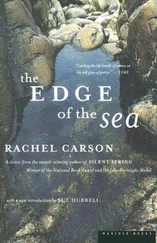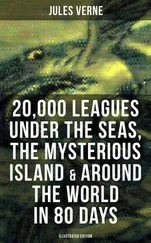Eventually the whales, as though to divide the sea’s food resources among them, became separated into three groups: the plankton-eaters, the fish-eaters, and the squid-eaters. The plankton-eating whales can exist only where there are dense masses of small shrimp or copepods to supply their enormous food requirements. This limits them, except for scattered areas, to arctic and antarctic waters and the high temperate latitudes. Fish-eating whales may find food over a somewhat wider range of ocean, but they are restricted to places where there are enormous populations of schooling fish. The blue water of the tropics and of the open ocean basins offers little to either of these groups. But that immense, square-headed, formidably toothed whale known as the cachalot or sperm whale discovered long ago what men have known for only a short time—that hundreds of fathoms below the almost untenanted surface waters of these regions there is an abundant animal life. The sperm whale has taken these deep waters for his hunting grounds; his quarry is the deepwater population of squids, including the giant squid Architeuthis, which lives pelagically at depths of 1500 feet or more. The head of the sperm whale is often marked with long stripes, which consist of a great number of circular scars made by the suckers of the squid. From this evidence we can imagine the battles that go on, in the darkness of the deep water, between these two huge creatures—the sperm whale with its 70-ton bulk, the squid with a body as long as 30 feet, and writhing, grasping arms extending the total length of the animal to perhaps 50 feet.
The greatest depth at which the giant squid lives is not definitely known, but there is one instructive piece of evidence about the depth to which sperm whales descend, presumably in search of the squids. In April 1932, the cable repair ship All America was investigating an apparent break in the submarine cable between Balboa in the Canal Zone and Esmeraldas, Ecuador. The cable was brought to the surface off the coast of Colombia. Entangled in it was a dead 45-foot male sperm whale. The submarine cable was twisted around the lower jaw and was wrapped around one flipper, the body, and the caudal flukes. The cable was raised from a depth of 540 fathoms, or 3240 feet. [9] For years people have speculated as to the function served by sound production on the part of marine species. It has been known for at least 20 years that the bat finds its way about in lightless caves and on dark nights by means of a physiological equivalent of radar, emitting a stream of high-frequency sound, which returns to it as echoes from any obstructions in its path. Could the sounds produced by certain fishes and marine mammals serve a similar purpose, aiding inhabitants of deep waters to swim in darkness and to find prey? Among the early tape recordings of underwater sound obtained by the Woods Hole Oceanographic Institution was a recording of some mysterious calls that emanated from waters so deep as surely to be lightless. They were distinguished by the fact that each call was followed by a faint echo of itself, so that for want of a better name the unknown author of these eerie sounds was christened the “echo fish.” Actual evidence of anything similar to the bat’s echo location or echo ranging has come only recently in the form of ingenious experiments performed on captive porpoises by W. N. Kellogg of Florida State University. Dr. Kellogg finds that the porpoises emit streams of underwater sound pulses by which they are able to swim accurately through a field of obstructions without collision. They could do this in water too turbid for vision or in darkness. When the experimenters introduced any object into the tank the porpoises gave forth bursts of sound signals by which the animals appeared to be trying to locate the object. Splashing on the surface, as from a hose or a shower of rain, “produced great disturbance, loud sound signals, undulating porpoise ‘alarm’ whistles, and ‘flight’ swimming reactions.” When food fish were introduced into the tank under such circumstances that they could not be located visually, the porpoises located them by streams of sound signals, turning their heads to right and left as the returning echoes allowed them to fix the exact location of their target.
Some of the seals also appear to have discovered the hidden food reserves of the deep ocean. It has long been something of a mystery where, and on what, the northern fur seals of the eastern Pacific feed during the winter, which they spend off the coast of North America from California to Alaska. There is no evidence that they are feeding to any great extent on sardines, mackerel, or other commercially important fishes. Presumably four million seals could not compete with commercial fishermen for the same species without the fact being known. But there is some evidence on the diet of the fur seals, and it is highly significant. Their stomachs have yielded the bones of a species of fish that has never been seen alive. Indeed, not even its remains have been found anywhere except in the stomachs of seals. Ichthyologists say that this ‘seal fish’ belongs to a group that typically inhabits very deep water, off the edge of the continental shelf.
How either whales or seals endure the tremendous pressure changes involved in dives of several hundred fathoms is not definitely known. They are warm-blooded mammals like ourselves. Caisson disease, which is caused by the rapid accumulation of nitrogen bubbles in the blood with sudden release of pressure, kills human divers if they are brought up rapidly from depths of 200 feet or so. Yet, according to the testimony of whalers, a baleen whale, when harpooned, can dive straight down to a depth of a half a mile, as measured by the amount of line carried out. From these depths, where it has sustained a pressure of half a ton on every inch of body, it returns almost immediately to the surface. The most plausible explanation is that, unlike the diver, who has air pumped to him while he is under water, the whale has in its body only the limited supply it carries down, and does not have enough nitrogen in its blood to do serious harm. The plain truth is, however, that we really do not know, since it is obviously impossible to confine a living whale and experiment on it, and almost as difficult to dissect a dead one satisfactorily.
At first thought it seems a paradox that creatures of such great fragility as the glass sponge and the jellyfish can live under the conditions of immense pressure that prevail in deep water. For creatures at home in the deep sea, however, the saving fact is that the pressure inside their tissues is the same as that without, and, as long as this balance is preserved, they are no more inconvenienced by a pressure of a ton or so than we are by ordinary atmospheric pressure. And most abyssal creatures, it must be remembered, live out their whole lives in a comparatively restricted zone, and are never required to adjust themselves to extreme changes of pressure.
But of course there are exceptions, and the real miracle of sea life in relation to great pressure is not the animal that lives its whole life on the bottom, bearing a pressure of perhaps five or six tons, but those that regularly move up and down through hundreds or thousands of feet of vertical change. The small shrimps and other planktonic creatures that descend into deep water during the day are examples. Fish that possess air bladders, on the other hand, are vitally affected by abrupt changes of pressure, as anyone knows who has seen a trawler’s net raised from a hundred fathoms. Apart from the accident of being captured in a net and hauled up through waters of rapidly diminishing pressures, fish may sometimes wander out of the zone to which they are adjusted and find themselves unable to return. Perhaps in their pursuit of food they roam upward to the ceiling of the zone that is theirs, and beyond whose invisible boundary they may not stray without meeting alien and inhospitable conditions. Moving from layer to layer of drifting plankton as they feed, they may pass beyond the boundary. In the lessened pressure of these upper waters the gas enclosed within the air bladder expands. The fish becomes lighter and more buoyant. Perhaps he tries to fight his way down again, opposing the upward lift with all the power of his muscles. If he does not succeed, he ‘falls’ to the surface, injured and dying, for the abrupt release of pressure from without causes distension and rupture of the tissues.
Читать дальше












